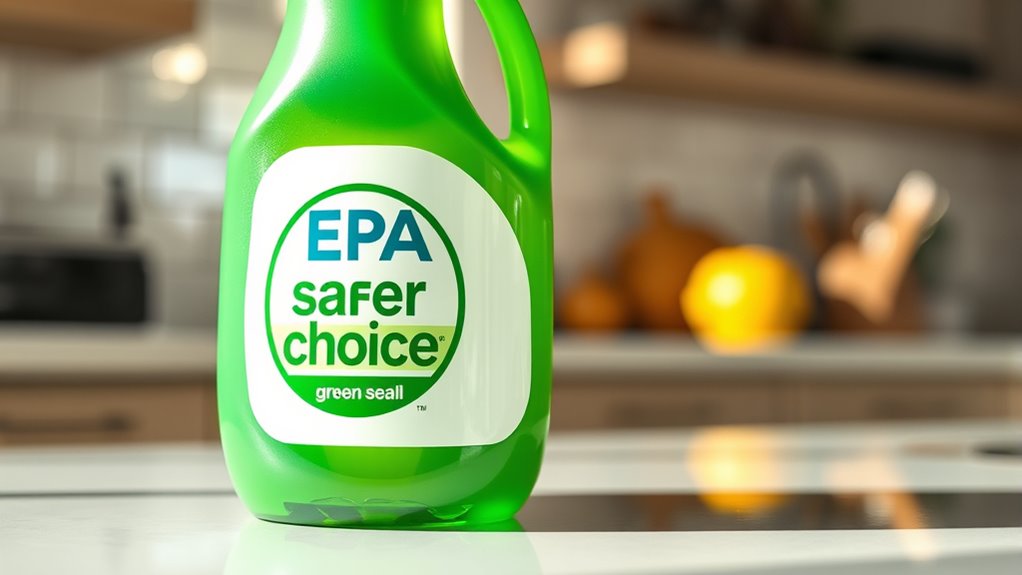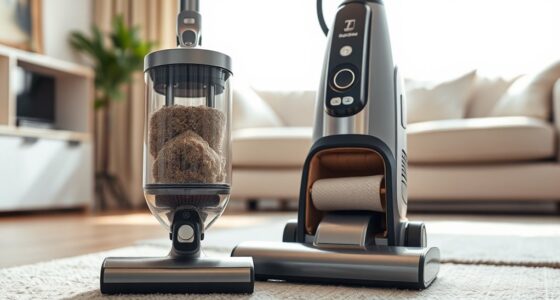Eco-labels like EPA Safer Choice and Green Seal help you identify products that meet strict environmental standards. They guarantee that items are tested for biodegradability, safety, and sustainability, so your choices support environmental health. These labels are based on rigorous certification processes and scientific testing, giving you confidence you’re choosing genuinely eco-friendly products. If you want to learn about what these labels stand for and how they benefit you, there’s more to discover ahead.
Key Takeaways
- Eco-labels like EPA Safer Choice and Green Seal certify products meet strict environmental and safety standards.
- They involve rigorous testing and certification processes to verify biodegradability and low toxicity.
- These labels help consumers identify environmentally responsible products that support sustainability efforts.
- Certification involves independent assessments of manufacturing practices, lifecycle impacts, and environmental benefits.
- Advances such as AI integration enhance the accuracy and transparency of eco-label verification.

Eco-labels like EPA Safer Choice and Green Seal play a crucial role in helping consumers make environmentally responsible choices. When you see these labels, you can trust that the products meet specific standards aimed at reducing environmental impact. These labels are more than just marketing tools; they’re backed by rigorous certification processes that ensure products adhere to strict criteria, including biodegradability standards. Understanding how these labels are awarded gives you confidence in your purchasing decisions and helps you support sustainability efforts.
Biodegradability standards are a key aspect of eco-labeling because they indicate how easily a product breaks down in the environment. Products that meet these standards decompose naturally without leaving harmful residues, minimizing pollution and conserving ecosystems. Certification processes for eco-labels involve detailed testing and evaluation to verify that products genuinely meet biodegradability criteria. For instance, a product must demonstrate that a significant percentage of its materials decompose within a specified period under controlled conditions. These standards prevent companies from making false claims about their products’ environmental benefits, ensuring that what you buy truly aligns with sustainable practices.
Biodegradability standards ensure products break down naturally, reducing pollution and supporting sustainable practices.
The certification process itself is thorough and transparent. Once a product manufacturer submits an application, independent laboratories often carry out testing to confirm biodegradability and other environmental criteria. Experts review manufacturing practices, ingredient lists, and product lifecycle impacts to determine eligibility for the label. This process isn’t quick or superficial; it involves multiple stages of assessment to ensure the product consistently meets the high standards set by organizations like the EPA or Green Seal. By doing so, the labels provide a reliable signal that the product has undergone rigorous scrutiny and adheres to recognized environmental benchmarks.
When you choose products with these eco-labels, you’re supporting companies committed to sustainability and environmental responsibility. These labels not only verify biodegradability but also often encompass other factors like reduced toxicity, resource efficiency, and safe ingredient use. Recognizing the certification process helps you understand that these labels are not just marketing claims but are supported by scientific testing and strict standards. For example, the integration of AI in environmental assessments demonstrates how technology is enhancing the accuracy and reliability of certification processes. This knowledge empowers you to select products that genuinely minimize environmental harm, contributing to a healthier planet.
Frequently Asked Questions
How Do Eco-Labels Influence Consumer Purchasing Decisions?
Eco-labels like EPA Safer Choice and Green Seal boost your consumer trust, making you feel confident about your choices. They influence your purchasing motivation by signaling products are environmentally friendly and safe. When you see these labels, you’re more likely to choose eco-conscious options, knowing they meet strict standards. This trust encourages healthier habits and supports sustainable brands, guiding you toward responsible shopping that aligns with your values.
Are Eco-Labels Recognized Globally or Only in Specific Regions?
Global recognition governs eco-labels, though regional recognition remains common. While some labels, like EPA Safer Choice and Green Seal, meet international standards, others primarily serve specific regions. You might find that certain eco-labels are more trusted locally, but internationally recognized labels tend to carry more weight across borders. Ultimately, understanding regional recognition helps you gauge a label’s credibility and whether it aligns with international standards for eco-friendly excellence.
What Industries Are Most Impacted by Eco-Label Certifications?
You’ll find that eco-label certifications most impact industries like cleaning products, personal care, and textiles. These sectors often face supply chain implications and may need manufacturing process adjustments to meet eco-label standards. By aligning your practices with eco-label requirements, you can enhance sustainability, appeal to eco-conscious consumers, and stay competitive in the market. Embracing these certifications can also streamline your supply chain and improve overall environmental responsibility.
How Often Are Eco-Label Standards Reviewed and Updated?
Eco-label standards are typically reviewed and updated through a renewal process that occurs every few years, often every 3 to 5 years. During this standard revision, certifying organizations reassess criteria to make sure they reflect current environmental science and industry practices. You should stay informed about these updates, as they may impact certification requirements and help you maintain compliance, demonstrating your commitment to sustainability.
Can a Product Have Multiple Eco-Labels Simultaneously?
Yes, a product can have multiple eco-labels simultaneously, and this often enhances eco-label credibility. While some worry about certification overlap, multiple labels usually indicate the product meets diverse standards, giving you confidence in its sustainability. This convergence helps make certain you’re choosing products that align with various environmental priorities, making your purchasing decisions more responsible and informed. Just check each label’s criteria to see how they complement each other.
Conclusion
By choosing eco-labels like EPA Safer Choice and Green Seal, you’re making a powerful impact—think of it as turning a tiny drop into a tidal wave of environmental change. These labels aren’t just symbols; they’re your roadmap to safer, greener products that protect both your health and the planet. So, next time you shop, remember, your choices ripple out like a storm, transforming the world one eco-friendly product at a time.









